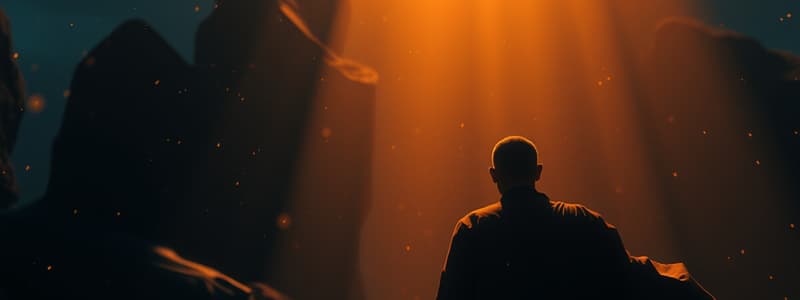Podcast
Questions and Answers
What type of shot is typically used to establish context in a scene?
What type of shot is typically used to establish context in a scene?
- Extreme close-up
- Wide shot (correct)
- Medium shot
- Close-up
Which lighting technique is characterized by the use of three different light sources?
Which lighting technique is characterized by the use of three different light sources?
- Natural light
- Soft lighting
- Three-point lighting (correct)
- High key lighting
What is the primary purpose of using depth of field in cinematography?
What is the primary purpose of using depth of field in cinematography?
- To influence audience focus (correct)
- To determine camera angle
- To establish shot types
- To create color grading
Which of the following cinematographers is known for their innovative use of digital techniques?
Which of the following cinematographers is known for their innovative use of digital techniques?
How does camera movement contribute to storytelling in film?
How does camera movement contribute to storytelling in film?
What is the effect of using hard light in cinematography?
What is the effect of using hard light in cinematography?
Which composition technique involves dividing the frame into thirds both vertically and horizontally?
Which composition technique involves dividing the frame into thirds both vertically and horizontally?
What is the primary role of color grading in film production?
What is the primary role of color grading in film production?
What modern trend involves the use of unmanned aerial vehicles in filmmaking?
What modern trend involves the use of unmanned aerial vehicles in filmmaking?
Which camera movement involves a smooth side-to-side motion without changing the location of the camera?
Which camera movement involves a smooth side-to-side motion without changing the location of the camera?
Flashcards are hidden until you start studying
Study Notes
Definition
- Cinematography is the art and technology of motion picture photography.
- Involves capturing visual images on film or digital media.
Key Elements
-
Camera Work
- Types of cameras (digital, film)
- Camera angles (high, low, eye level)
- Camera movement (pan, tilt, zoom, dolly)
-
Lighting
- Quality of light (hard vs. soft)
- Lighting techniques (three-point lighting, natural light)
- Color temperature and its impact on mood
-
Composition
- Rule of thirds
- Leading lines and framing
- Balance and symmetry
-
Shot Types
- Wide shot (establishes context)
- Medium shot (focus on subjects)
- Close-up (intimate detail)
- Extreme close-up (intense focus)
-
Focus
- Depth of field (shallow vs. deep focus)
- Rack focus (shifting focus between subjects)
-
Color and Tone
- Color grading and its emotional impact
- Use of filters (ND filters, polarizers)
Cinematic Techniques
-
Camera angles and perspective
- Influences audience perception and engagement.
-
Movement
- Use of steadicam, handheld shots, or drone footage for dynamic storytelling.
Importance in Film
- Establishes mood, tone, and atmosphere.
- Guides audience’s emotional response and interpretation.
- Supports narrative structure and character development.
Modern Trends
- Increased use of digital cinematography and special effects.
- Emergence of virtual reality (VR) and augmented reality (AR) in filmmaking.
- Use of drones for aerial cinematography.
Notable Cinematographers
- Roger Deakins
- Emmanuel Lubezki
- Gordon Willis
Conclusion
- Cinematography is a crucial component of filmmaking that encompasses various techniques and artistic choices, significantly influencing the storytelling process and overall viewer experience.
Definition
- Cinematography combines art and technology in motion picture photography.
- It involves capturing visual images using film or digital media.
Key Elements
-
Camera Work
- Different camera types include digital and film.
- Camera angles can be high, low, or eye level for varied perspectives.
- Movement techniques include pan, tilt, zoom, and dolly shots.
-
Lighting
- Quality of light can be categorized as hard or soft, affecting mood.
- Techniques like three-point lighting and natural light optimize visuals.
- Color temperature influences the emotional tone of scenes.
-
Composition
- The rule of thirds guides visual balance and focus.
- Leading lines direct the viewer's attention, while framing enhances context.
- Balance and symmetry contribute to aesthetic appeal.
-
Shot Types
- Wide shots establish the setting and context of scenes.
- Medium shots concentrate on subjects for character development.
- Close-ups capture intimate details, while extreme close-ups focus intensely.
-
Focus
- Depth of field can be shallow or deep, affecting scene perception.
- Rack focus shifts attention between different subjects within a shot.
-
Color and Tone
- Color grading alters scenes’ emotional impacts by modifying hues.
- Filters like ND and polarizers are used to control light and contrast.
Cinematic Techniques
- Camera angles and perspective impact audience engagement and interpretation.
- Movement through steadicam, handheld shots, or drones adds dynamic storytelling.
Importance in Film
- Cinematography shapes the mood, tone, and atmosphere of a film.
- It guides emotional responses, influencing viewer interpretation.
- Supports narrative structure and character nuances.
Modern Trends
- Digital cinematography and special effects are increasingly common.
- Virtual reality (VR) and augmented reality (AR) are emerging in filmmaking.
- Drones are used for unique aerial shots, expanding storytelling techniques.
Notable Cinematographers
- Roger Deakins is known for his impactful visual style.
- Emmanuel Lubezki is recognized for his innovative use of natural light.
- Gordon Willis is celebrated for his influential work in film lighting.
Conclusion
- Cinematography is essential in filmmaking, encompassing numerous techniques and artistic decisions that profoundly affect storytelling and viewer experience.
Studying That Suits You
Use AI to generate personalized quizzes and flashcards to suit your learning preferences.




